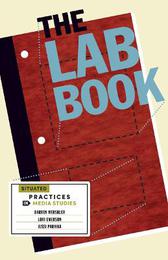
|
The Lab Book: Situated Practices in Media Studies
Paperback / softback
Main Details
| Title |
The Lab Book: Situated Practices in Media Studies
|
| Authors and Contributors |
By (author) Darren Wershler
|
|
By (author) Lori Emerson
|
|
By (author) Jussi Parikka
|
| Physical Properties |
| Format:Paperback / softback | | Pages:328 | | Dimensions(mm): Height 216,Width 140 |
|
| Category/Genre | Film theory and criticism |
|---|
| ISBN/Barcode |
9781517902186
|
| Classifications | Dewey:001.4 |
|---|
| Audience | | General | | Professional & Vocational | |
|---|
| Illustrations |
41 black & whilte illustrations
|
|
Publishing Details |
| Publisher |
University of Minnesota Press
|
| Imprint |
University of Minnesota Press
|
| Publication Date |
19 April 2022 |
| Publication Country |
United States
|
Description
An important new approach to the study of laboratories, presenting a practical method for understanding labs in all walks of life From the "Big Science" of Bell Laboratories to the esoteric world of seance chambers to university media labs to neighborhood makerspaces, places we call "labs" are everywhere-but how exactly do we account for the wide variety of ways that they produce knowledge? More than imitations of science and engineering labs, many contemporary labs are hybrid forms that require a new methodological and theoretical toolkit to describe. The Lab Book investigates these vital, creative spaces, presenting readers with the concept of the "hybrid lab" and offering an extended-and rare-critical investigation of how labs have proliferated throughout culture. Organized by interpretive categories such as space, infrastructure, and imaginaries, The Lab Book uses both historical and contemporary examples to show how laboratories have become fundamentally connected to changes in the contemporary university. Its wide reach includes institutions like the MIT Media Lab, the Tuskegee Institute's Jesup Wagon, ACTLab, and the Media Archaeological Fundus. The authors cover topics such as the evolution and delineation of lab-based communities, how labs' tools and technologies contribute to defining their space, and a glossary of key hybrid lab techniques. Providing rich historical breadth and depth, The Lab Book brings into focus a critical, but often misunderstood, aspect of the contemporary arts and humanities.
Author Biography
Darren Wershler is Concordia University Research Chair in media and contemporary literature, cofounder of the Media History Research Centre, and Director of the Residual Media Depot in the Milieux Institute at Concordia University in Montreal. Wershler's other books include Guy Maddin's My Winnipeg; The Iron Whim: A Fragmented History of Typewriting; and FREE as in Speech and Beer: Open Source, Peer-to-Peer, and the Economics of the Online Revolution. Lori Emerson is associate professor in the Department of English and director of the Intermedia Arts, Writing, and Performance Program at the University of Colorado at Boulder. She is founding director of the Media Archaeology Lab and author of Reading Writing Interfaces: From the Digital to the Bookbound (Minnesota, 2014). Jussi Parikka is professor of technological culture and aesthetics at the Winchester School of Art (University of Southampton) and founding codirector of the Archaeologies of Media and Technology research unit. He is visiting professor at the Academy of Performing Arts, Prague, as research leader for the project Operational Images. He is author of A Geology of Media; Insect Media: An Archaeology of Animals and Technology; and The Anthrobscene; coauthor of Remain; and editor of Digital Memory and the Archive, all from Minnesota.
Reviews"Lively, timely, and filled with vivid examples, The Lab Book is a highly readable and critically sophisticated account of current lab culture. Written by three distinguished practitioners, it examines the rhetoric that links real and imaginary ideas of experimentality with systems of power and authority across a surprising range of disciplines. A fun, smart, useful guide to ongoing work in media studies."-Johanna Drucker, author of Visualization and Interpretation: Humanistic Approaches to Display
|